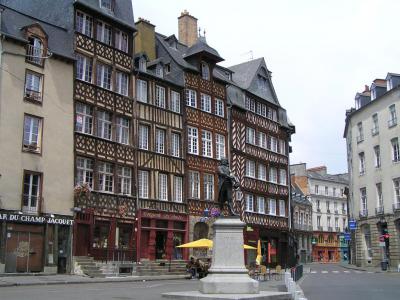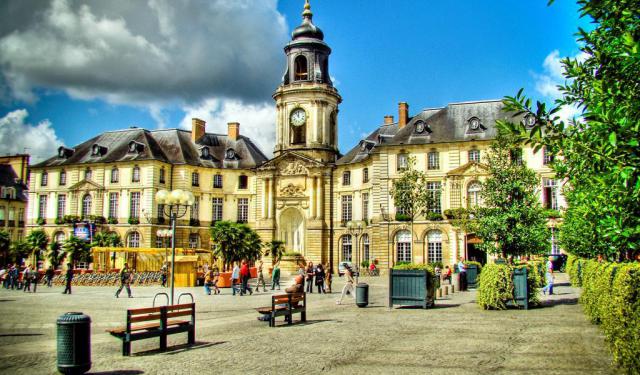Place du Champ Jacquet (Champ-Jacquet Square), Rennes
Perhaps the most photogenic spot in Rennes, Champ-Jacquet Square takes its names after the gate Porte Jacquet, formerly part of the old (15th-century) bulwark, located nearby.
The triangular square's architecture traces the history of Rennes from as far back as the Middle Ages and bears the scars of the Fire of 1720 that ravaged the city. That year, the flames totally consumed the southern part of the square, while sparing its northern part, thus clearly marking the limits of the fire's advance. Stone houses built after the fire today stand face-to-face with the survived structures of wood and plaster.
These celebrated half-timbered houses form a wicked "house of cards" composition, looking at which unstable and uneven façades is now hard to imagine that, back in the 17th century, when they were built, the opposite was true: the buildings were impressively solid and regular.
These furnished dwellings served as accommodation for lawyers who flocked here to work at the Parliament. The opening of Rue Leperdit (left) created a void that caused the façades to slope. With no stone wall to separate the buildings the latter warped over time – a problem quite typical in wood construction: shifting suppleness of the structure.
In the center of the square stands a two-meter bronze statue of Jean Leperdit, a mayor of Rennes during the turbulent period of the Revolution. The mayor is depicted tearing up a royal edict with a list of those condemned to the guillotine. Praised as a ray of light in the time of darkness, Leperdit was famously reported to have said, whilst ripping that document: "They are outside the law, [but] not outside humanity."
If you look to the side, at number 5, you will see the Hôtel Hay de Tizé. Built in 1665, this is a stunning example of a fusion of genres and materials: a half-timbered façade, a tuffeau-stone first floor and granite foundations. In other words, an architectural cocktail, Breton-style.
Since the installation of the second Metro line, Champ-Jacquet Square has been pedestrianized. Today, the square is a condensation of Rennes' life and is once again a rendezvous place, abundant in restaurants, cafes, and creperies, as well as boutiques specialized in "made in France" merchandise.
The triangular square's architecture traces the history of Rennes from as far back as the Middle Ages and bears the scars of the Fire of 1720 that ravaged the city. That year, the flames totally consumed the southern part of the square, while sparing its northern part, thus clearly marking the limits of the fire's advance. Stone houses built after the fire today stand face-to-face with the survived structures of wood and plaster.
These celebrated half-timbered houses form a wicked "house of cards" composition, looking at which unstable and uneven façades is now hard to imagine that, back in the 17th century, when they were built, the opposite was true: the buildings were impressively solid and regular.
These furnished dwellings served as accommodation for lawyers who flocked here to work at the Parliament. The opening of Rue Leperdit (left) created a void that caused the façades to slope. With no stone wall to separate the buildings the latter warped over time – a problem quite typical in wood construction: shifting suppleness of the structure.
In the center of the square stands a two-meter bronze statue of Jean Leperdit, a mayor of Rennes during the turbulent period of the Revolution. The mayor is depicted tearing up a royal edict with a list of those condemned to the guillotine. Praised as a ray of light in the time of darkness, Leperdit was famously reported to have said, whilst ripping that document: "They are outside the law, [but] not outside humanity."
If you look to the side, at number 5, you will see the Hôtel Hay de Tizé. Built in 1665, this is a stunning example of a fusion of genres and materials: a half-timbered façade, a tuffeau-stone first floor and granite foundations. In other words, an architectural cocktail, Breton-style.
Since the installation of the second Metro line, Champ-Jacquet Square has been pedestrianized. Today, the square is a condensation of Rennes' life and is once again a rendezvous place, abundant in restaurants, cafes, and creperies, as well as boutiques specialized in "made in France" merchandise.
Want to visit this sight? Check out these Self-Guided Walking Tours in Rennes. Alternatively, you can download the mobile app "GPSmyCity: Walks in 1K+ Cities" from Apple App Store or Google Play Store. The app turns your mobile device to a personal tour guide and it works offline, so no data plan is needed when traveling abroad.
Place du Champ Jacquet (Champ-Jacquet Square) on Map
Sight Name: Place du Champ Jacquet (Champ-Jacquet Square)
Sight Location: Rennes, France (See walking tours in Rennes)
Sight Type: Attraction/Landmark
Guide(s) Containing This Sight:
Sight Location: Rennes, France (See walking tours in Rennes)
Sight Type: Attraction/Landmark
Guide(s) Containing This Sight:
Walking Tours in Rennes, France
Create Your Own Walk in Rennes
Creating your own self-guided walk in Rennes is easy and fun. Choose the city attractions that you want to see and a walk route map will be created just for you. You can even set your hotel as the start point of the walk.
Rennes Introduction Walking Tour
Rennes began its existence as Condate Redonum, a Gallic and Roman town at the confluence of the Ille and Vilaine rivers. During medieval times, it became one of the three major cities of Brittany, together with Vannes and Nantes. The city played an important role in the Stamped Paper Revolt in 1675. During the French Revolution, it became the headquarters of the republican army in the fighting... view more
Tour Duration: 2 Hour(s)
Travel Distance: 2.9 Km or 1.8 Miles
Tour Duration: 2 Hour(s)
Travel Distance: 2.9 Km or 1.8 Miles
Rennes Historical Churches Walking Tour
Historical churches occupy a significant place in the cultural identity of Rennes, France. Travelers with a keen interest in religious history and architecture will find plenty to look at in this town.
Standing out majestically among the local ecclesiastical landmarks is Rennes Cathedral. Built in the 12th century, it underwent a centuries-long transformation from its Gothic origins to its... view more
Tour Duration: 1 Hour(s)
Travel Distance: 2.1 Km or 1.3 Miles
Standing out majestically among the local ecclesiastical landmarks is Rennes Cathedral. Built in the 12th century, it underwent a centuries-long transformation from its Gothic origins to its... view more
Tour Duration: 1 Hour(s)
Travel Distance: 2.1 Km or 1.3 Miles
Medieval Houses Walking Tour
From the late Middle Ages through to the end of the Ancien Régime (the period of Bourbon rule in France, from 1589 to 1789), a multitude of half-timbered houses were built in Brittany, and particularly in Rennes. Even today, the Breton capital is where half-timbered houses remain the most prevalent style of architecture, and a key element of the cultural heritage of the region reiterated in many... view more
Tour Duration: 1 Hour(s)
Travel Distance: 0.9 Km or 0.6 Miles
Tour Duration: 1 Hour(s)
Travel Distance: 0.9 Km or 0.6 Miles






